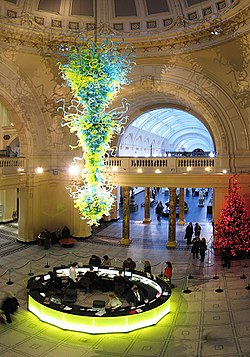Victoria and Albert Museum


The Victoria and Albert Museum (often abbreviated as the V&A) in London is the world's largest museum of applied art (decorative arts and design). Named after Queen Victoria and Prince Albert, it was founded in 1852.
The V&A has a permanent collection of over 4.5 million objects. It covers 12.5 acres (5 hectares)[1][2] and 145 galleries. Its collection spans 5000 years of art, from ancient times to the present day, in virtually every medium, from the cultures of Europe, North America, Asia and North Africa. The museum is sponsored by the Department for Culture, Media and Sport.
The holdings of ceramics, glass, textiles, costumes, silver, ironwork, jewellery, furniture, medieval objects, sculpture, prints and printmaking, drawings and photographs are among the largest and most comprehensive in the world.[3]
The museum possesses the world's largest collection of post-classical sculpture, the holdings of Italian Renaissance items are the largest outside Italy. The departments of Asia include art from South Asia, China, Japan, Korea and the Islamic world. The East Asian collections are among the best in Europe, with particular strengths in ceramics and metalwork, while the Islamic collection, with the Musée du Louvre and Metropolitan Museum of Art, New York, is amongst the largest in the world.
The V&A is in what is called London's "Albertopolis", an area of immense cultural, scientific and educational importance.[4] Near it are the Natural History Museum, the Science Museum, Imperial College, the Albert Hall and the Albert Memorial.
Since 2001, the Museum has embarked on a major £150m renovation program[5] which has seen a major overhaul of the departments including the introduction of newer galleries, gardens, shops and visitor facilities. As with other national UK museums, admission to the museum is free.
References[change | change source]
- ↑ Future Plan. Victoria and Albert Museum
- ↑ John Physick 1982. The Victoria and Albert Museum: the history of its building.
- ↑ "Victoria and Albert Museum - London" (html). Inexhibit. Retrieved 2017-03-28.
- ↑ Sheppard F.H.W. (ed) 1975. Survey of London XXXVIII: The Museums area of South Kensington and Westminster.
- ↑ BBC News | ARTS | V&A to have £150m facelift
